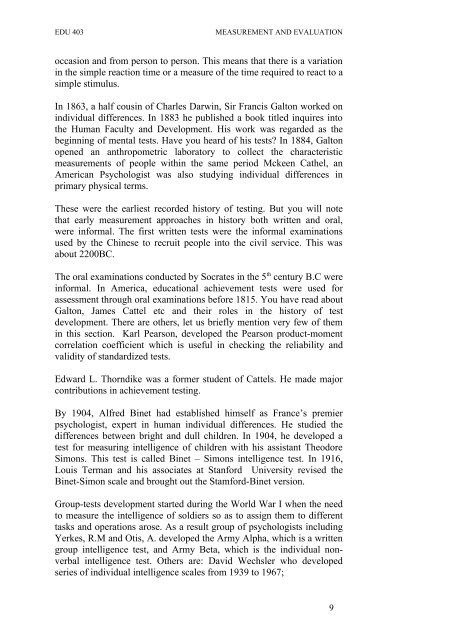EDU 403 Measurement and Evaluation - National Open University ...
EDU 403 Measurement and Evaluation - National Open University ...
EDU 403 Measurement and Evaluation - National Open University ...
You also want an ePaper? Increase the reach of your titles
YUMPU automatically turns print PDFs into web optimized ePapers that Google loves.
<strong>EDU</strong> <strong>403</strong> MEASUREMENT AND EVALUATION<br />
occasion <strong>and</strong> from person to person. This means that there is a variation<br />
in the simple reaction time or a measure of the time required to react to a<br />
simple stimulus.<br />
In 1863, a half cousin of Charles Darwin, Sir Francis Galton worked on<br />
individual differences. In 1883 he published a book titled inquires into<br />
the Human Faculty <strong>and</strong> Development. His work was regarded as the<br />
beginning of mental tests. Have you heard of his tests? In 1884, Galton<br />
opened an anthropometric laboratory to collect the characteristic<br />
measurements of people within the same period Mckeen Cathel, an<br />
American Psychologist was also studying individual differences in<br />
primary physical terms.<br />
These were the earliest recorded history of testing. But you will note<br />
that early measurement approaches in history both written <strong>and</strong> oral,<br />
were informal. The first written tests were the informal examinations<br />
used by the Chinese to recruit people into the civil service. This was<br />
about 2200BC.<br />
The oral examinations conducted by Socrates in the 5 th century B.C were<br />
informal. In America, educational achievement tests were used for<br />
assessment through oral examinations before 1815. You have read about<br />
Galton, James Cattel etc <strong>and</strong> their roles in the history of test<br />
development. There are others, let us briefly mention very few of them<br />
in this section. Karl Pearson, developed the Pearson product-moment<br />
correlation coefficient which is useful in checking the reliability <strong>and</strong><br />
validity of st<strong>and</strong>ardized tests.<br />
Edward L. Thorndike was a former student of Cattels. He made major<br />
contributions in achievement testing.<br />
By 1904, Alfred Binet had established himself as France’s premier<br />
psychologist, expert in human individual differences. He studied the<br />
differences between bright <strong>and</strong> dull children. In 1904, he developed a<br />
test for measuring intelligence of children with his assistant Theodore<br />
Simons. This test is called Binet – Simons intelligence test. In 1916,<br />
Louis Terman <strong>and</strong> his associates at Stanford <strong>University</strong> revised the<br />
Binet-Simon scale <strong>and</strong> brought out the Stamford-Binet version.<br />
Group-tests development started during the World War I when the need<br />
to measure the intelligence of soldiers so as to assign them to different<br />
tasks <strong>and</strong> operations arose. As a result group of psychologists including<br />
Yerkes, R.M <strong>and</strong> Otis, A. developed the Army Alpha, which is a written<br />
group intelligence test, <strong>and</strong> Army Beta, which is the individual nonverbal<br />
intelligence test. Others are: David Wechsler who developed<br />
series of individual intelligence scales from 1939 to 1967;<br />
9

















